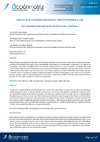Please use this identifier to cite or link to this item:
https://accedacris.ulpgc.es/jspui/handle/10553/57348
| Title: | Indicios de autoorganización en el baloncesto profesional NBA | Other Titles: | Self-organization sings in NBA Professional Basketball | Authors: | Saá Guerra, Yves de Martín González, Juan Manuel García Manso, Juan Manuel |
UNESCO Clasification: | 120714 Formulación de sistemas | Keywords: | Basketball NBA Self-organization Small-World Network Scale Free Network, et al |
Issue Date: | 2014 | Journal: | Acciónmotriz | Abstract: | El flujo de juego en un partido de baloncesto y el diseño de su estructura puede ser descrito como en otros fenómenos naturales.
La forma y funcionalidad de un equipo están estrechamente relacionadas con el rendimiento. El baloncesto es un deporte de
cooperación -oposición. Los jugadores de un mismo equipo colaboran entre sí, y a su vez se oponen a los contrincantes. Estos
procesos tienen lugar de manera simultánea y continua durante todo el partido. Los jugadores son capaces de resolver la situación
mediante interacciones locales. Estas interacciones son no lineales principalmente y están estrechamente relacionadas con un parámetro de orden: el marcador. Los equipos son capaces de modificar su flujo interno para ganar el partido. Resuelven la situación
con sólo unos pasos (red de mundo pequeño), pero si la situación se vuelve crítica, modifican el flujo de juego en forma de red libre
de escala. Por ello pueden considerarse sistemas autoorganizados The game flow in a basketball game and the design of its structure can be described as in many others natural systems. The shape and functionality of a team are closely related to performance in several sports. Basketball is a collaboration-opposition sport. During a basketball game we can witness how players of the same team collaborate with each other, and in turn compete against the opposing players. These processes take place simultaneously and continuously during game time. Players are able to resolve the situation through local interactions. These interactions are mainly nonlinear and are closely related to an order parameter: the score. Teams are able to modify their game flow in order to win the game. Teams resolve the game situation with only a few steps (Small-World Network), but if the situation becomes more critical, they seem to modify the game flow into a Scale-free network. Therefore teams would be considered as self-organizing systems. |
URI: | https://accedacris.ulpgc.es/handle/10553/57348 | ISSN: | 1989-2837 | Source: | Acciónmotriz [ISSN 1989-2837], n. 13, p. 63-76, (2014) | URL: | http://dialnet.unirioja.es/servlet/articulo?codigo=6698423 |
| Appears in Collections: | Artículos |
Page view(s)
163
checked on May 31, 2025
Download(s)
77
checked on May 31, 2025
Google ScholarTM
Check
Share
Export metadata
Items in accedaCRIS are protected by copyright, with all rights reserved, unless otherwise indicated.
